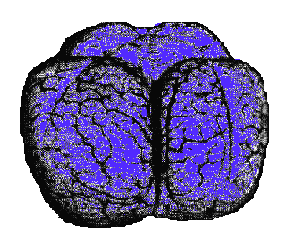
Dolphins
have very large and folded brains, which (besides the large body mass)
suggest exceptional intellectual capacity. According to brain researcher
Pilleri, it can be called into question whether or not the brains of Homo
Sapiens(human) are the highest in the rankings. Dolphins are easily trained
and they learn exceptionally fast.
However,
recent research has shown that the amount of braincells found in dolphins
is comparatively small. Scientists are coming to the conclusion that the
dolphin is probably less intelligent than once thought. Humans have many
more braincells and can therefore learn and think a lot quicker.


Brain of a human
Brain of the bottlenosed dolphin
If
"intelligence" was simply determined by absolute brain size, there would
be no difficulty in deciding which species was top. This table shows the
approximate brain weights and body weights of mammals in order of brain
weight:
SPECIES:
BRAIN WEIGHT: BODY
WEIGHT:
(approx.)
(approx.)
grams
tonnes
SPERM
WHALE (MALE) 7,820
37.00
AFRICAN
ELEPHANT
7,500
5.00
FIN
WHALE
6,930
90.00
KILLER
WHALE
5,620
6.00
BOTTLENOSE
DOLPHIN 1,600
0.17
HUMAN
1,500
0.07
COW
500
0.6
But
as the species with the biggest brains also tend to be the ones with the
biggest bodies, it might be that large animals just need larger brains
to control and maintain their larger bodies. Even when we talk of "intelligence"
in a general way, we mean something more than the sum of body control systems.
A simple way to make allowance for different body weights is to express
brain weight as a percentage of body weight, as you can see in the table
below:
SPECIES:
BRAIN WEIGHT AS % OF BODY WEIGHT:
HUMAN
2.10
BOTTLENOSE
DOLPHIN 0.94
AFRICAN
ELEPHANT 0.15
KILLER
WHALE
0.09
COW
0.08
SPERM
WHALE (MALE) 0.02
FIN
WHALE
0.01
In
this list humans are seen to have a great advantage over the others, and
we also have a very different view of the large whales. Of course, these
are only very limited lists to illustrate this type of approach to the
problem.
Researchers
have made far more extensive and sophisticated attempts to investigate
comparative intelligence in this way. There is, however, a basic problem
in compiling lists of this type, and that is deciding which weights to
take as typical of a species. For example, normal humans can have brains
weighing anything between 900 and 2,000 grams. The weight of an individual
brain will also vary depending on whether it is fresh or preserved, and
on exactly which parts are included. Body weight varies greatly between
individuals, and in some whale species the weight of individual animals
can vary by about 40% over a year because of their seasonal feeding habits.
The brain weight to body weight relation-ship varies with age young mammals
have proportionally smaller bodies and larger heads, and brain size decreases
significantly in old age. There can be marked sex differences in body size,
for example adult female baleen whales in many species are much larger
than males, while in sperm whales it is the adult males which are much
larger than the females. Normal variations in brain and body size have
only been well studied in a, few species, and usually a researcher seeking
to compile extensive brain and body weight lists has no choice but to take
whatever specimens are available, regardless of whether the material is
really representative of the species as a whole.
Some
of the most extensive modern comparative studies have been made by Jerison
(e.g.1978), who has developed an index, the encephalization quotient (EQ),
to express the brain weight/body weight relationship. His studies do show
some cetaceans (e.g. toothed whales like the killer whale and sperm whale)
with an EQ similar to humans. However, other studies conclude that relative
brain size is not necessarily related to "intelligence". Pilleri, Gihr
and Kraus (1985) made an exhaustive study of rodent brain size in relation
to behavior and concluded that "intelligence", whether human or animal,
is not a unified brain function, but one which is too complex to be characterized
with a single numerical index. They found that cerebral quotients (various
ways of expressing relative brain and body size) are generally inconclusive
as criteria for mammalian "intelligence".
The
degree of convolution or folding of the cortical brain surface has often
in the past been taken as an absolute indicator of "intelligence". However,
more recent work regards this as simply a mechanical reflection of an increase
in neocortical volume. Jerison (1979), for example, regards degree of convolution
and absolute brain size as equivalent measures, speculating that the extra
volume is required to accommodate increasingly complex connections between
the brain cells. Ridgway (1986) presents evidence from a variety of sources
to show that bottlenose dolphins have a much higher index of folding than
humans. However, as Ridgway (1986) also explains, the neocortex of the
cetacean brain is relatively thin - about half that of humans - giving
a total average dolphin neocortical volume about 80% of that of humans.
Also the cetacean neocortical structure is generally very much simpler
than that of land mammals, and does not therefore conform to the assumptions
that more convoluted neocortices are necessarily more voluminous or more
complex. This is not the only anomaly, for example compare the convoluted
appearances of the horse and chimpanzee brains.
Although
there are a lot of experiments done, still a lot of questions remain unanswered....


